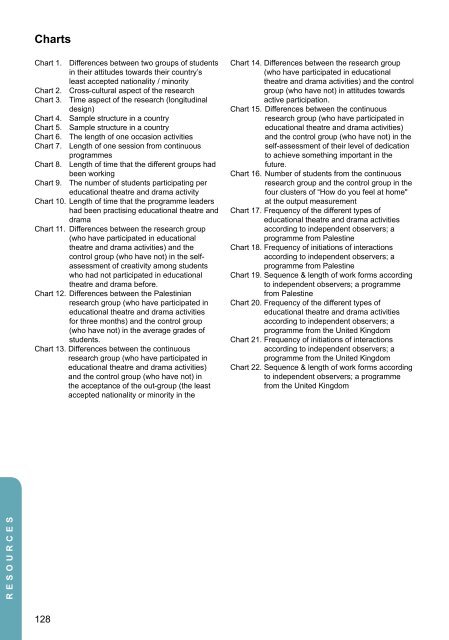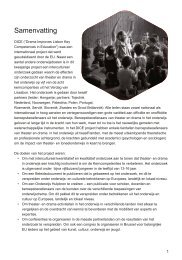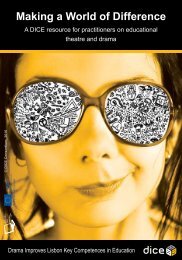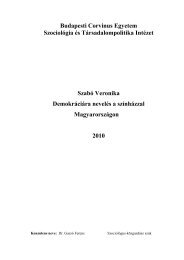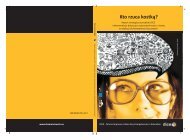Policy Paper - Drama Improves Lisbon Key Competences in Education
Policy Paper - Drama Improves Lisbon Key Competences in Education
Policy Paper - Drama Improves Lisbon Key Competences in Education
Create successful ePaper yourself
Turn your PDF publications into a flip-book with our unique Google optimized e-Paper software.
Charts<br />
Chart 1. Differences between two groups of students<br />
<strong>in</strong> their attitudes towards their country’s<br />
least accepted nationality / m<strong>in</strong>ority<br />
Chart 2. Cross-cultural aspect of the research<br />
Chart 3. Time aspect of the research (longitud<strong>in</strong>al<br />
design)<br />
Chart 4. Sample structure <strong>in</strong> a country<br />
Chart 5. Sample structure <strong>in</strong> a country<br />
Chart 6. The length of one occasion activities<br />
Chart 7. Length of one session from cont<strong>in</strong>uous<br />
programmes<br />
Chart 8. Length of time that the different groups had<br />
been work<strong>in</strong>g<br />
Chart 9. The number of students participat<strong>in</strong>g per<br />
educational theatre and drama activity<br />
Chart 10. Length of time that the programme leaders<br />
had been practis<strong>in</strong>g educational theatre and<br />
drama<br />
Chart 11. Differences between the research group<br />
(who have participated <strong>in</strong> educational<br />
theatre and drama activities) and the<br />
control group (who have not) <strong>in</strong> the selfassessment<br />
of creativity among students<br />
who had not participated <strong>in</strong> educational<br />
theatre and drama before.<br />
Chart 12. Differences between the Palest<strong>in</strong>ian<br />
research group (who have participated <strong>in</strong><br />
educational theatre and drama activities<br />
for three months) and the control group<br />
(who have not) <strong>in</strong> the average grades of<br />
students.<br />
Chart 13. Differences between the cont<strong>in</strong>uous<br />
research group (who have participated <strong>in</strong><br />
educational theatre and drama activities)<br />
and the control group (who have not) <strong>in</strong><br />
the acceptance of the out-group (the least<br />
accepted nationality or m<strong>in</strong>ority <strong>in</strong> the<br />
Chart 14. Differences between the research group<br />
(who have participated <strong>in</strong> educational<br />
theatre and drama activities) and the control<br />
group (who have not) <strong>in</strong> attitudes towards<br />
active participation.<br />
Chart 15. Differences between the cont<strong>in</strong>uous<br />
research group (who have participated <strong>in</strong><br />
educational theatre and drama activities)<br />
and the control group (who have not) <strong>in</strong> the<br />
self-assessment of their level of dedication<br />
to achieve someth<strong>in</strong>g important <strong>in</strong> the<br />
future.<br />
Chart 16. Number of students from the cont<strong>in</strong>uous<br />
research group and the control group <strong>in</strong> the<br />
four clusters of “How do you feel at home"<br />
at the output measurement<br />
Chart 17. Frequency of the different types of<br />
educational theatre and drama activities<br />
accord<strong>in</strong>g to <strong>in</strong>dependent observers; a<br />
programme from Palest<strong>in</strong>e<br />
Chart 18. Frequency of <strong>in</strong>itiations of <strong>in</strong>teractions<br />
accord<strong>in</strong>g to <strong>in</strong>dependent observers; a<br />
programme from Palest<strong>in</strong>e<br />
Chart 19. Sequence & length of work forms accord<strong>in</strong>g<br />
to <strong>in</strong>dependent observers; a programme<br />
from Palest<strong>in</strong>e<br />
Chart 20. Frequency of the different types of<br />
educational theatre and drama activities<br />
accord<strong>in</strong>g to <strong>in</strong>dependent observers; a<br />
programme from the United K<strong>in</strong>gdom<br />
Chart 21. Frequency of <strong>in</strong>itiations of <strong>in</strong>teractions<br />
accord<strong>in</strong>g to <strong>in</strong>dependent observers; a<br />
programme from the United K<strong>in</strong>gdom<br />
Chart 22. Sequence & length of work forms accord<strong>in</strong>g<br />
to <strong>in</strong>dependent observers; a programme<br />
from the United K<strong>in</strong>gdom<br />
REsources<br />
128


